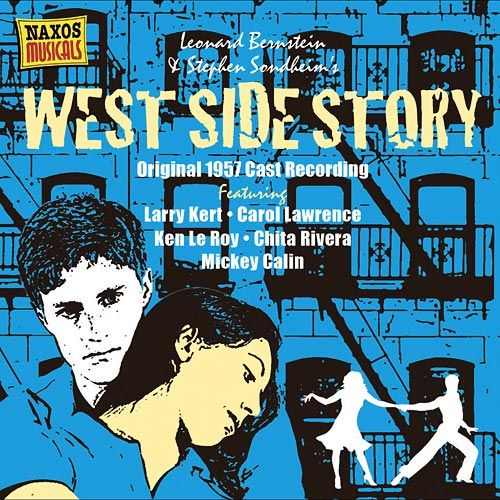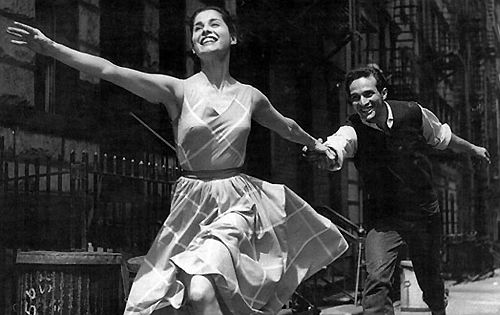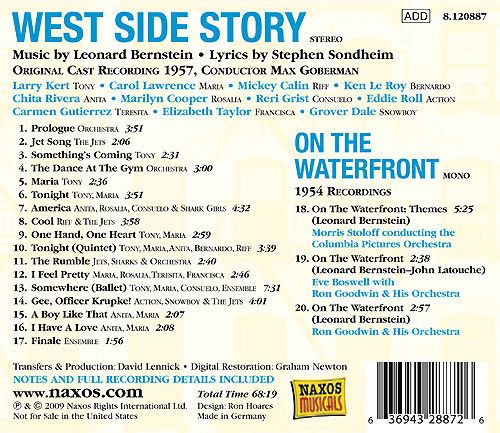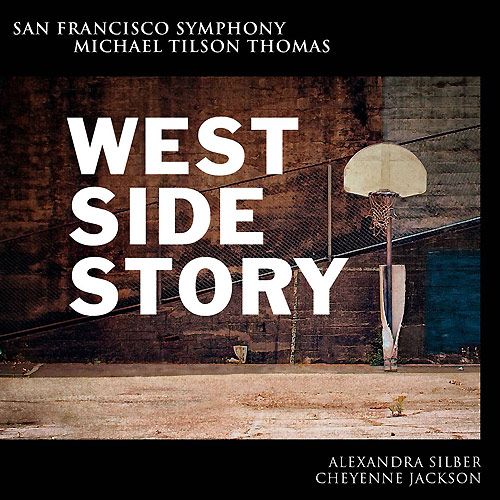wimpel69
09-23-2014, 11:00 AM
The sharing period on these albums has ended. No more requests, please!
On January 9, 1949, Leonard Bernstein entered this into his log: "Jerry R. [Robbins] called today with a
noble idea: a modern version of Romeo and Juliet set in slums at the coincidence of Easter-Passover celebrations.
Feelings run high between Jews and Catholics. Former: Capulets; latter: Montagues. Juliet is Jewish." The newly
formed State of Israel and the resultant war made the idea topical, and Bernstein, of Jewish descent, was familiar
with Catholicism.
From the beginning, Robbins suggested that Arthur Laurents write the book, which was to be called East Side
Story. However, other projects forced them to put off work until 1955. In the late summer of that year, while
in Los Angeles with Laurents, Bernstein saw a newspaper article about fights between Mexican and Anglo gangs
on Olivera Street. The two decided that recently arrived Puerto Ricans and first-generation Americans born of
European immigrants would be a more accessible alternative to the Capulets and Montagues than would Jews
and Catholics, and Latin American rhythms began to take shape in Bernstein's head. Neither Laurents nor
Bernstein wanted to compose the lyrics for the songs, and they enlisted the 26-year-old Stephen Sondheim
in October 1955. The title was changed to West Side Story when the creators realized that gang warfare
in New York had moved from the East Side to the West. West Side Story opened at New York's Winter Garden
Theater on September 26, 1957, and has remained in the repertory ever since. The film version of 1961 was
a smashing success, earning 10 Oscars, including Best Picture. West Side Story is one of Bernstein's most
impressive achievements in any style of composition. Its mixture of Latin American rhythms, big band jazz
harmonies and instrumentation, contrapuntal writing, and colloquial language is handled with such skill and
sensitivity that the result makes it seem as though these elements had always coexisted.
Arthur Laurents' book for West Side Story is not really a retelling or paraphrase of Shakespeare's Romeo and
Juliet, but rather uses the play as a point of departure. Feuding families become rival gangs of different
ethnic backgrounds, and Tony (Romeo) kills Maria's (Juliet) brother, but the "star-crossed" lovers do not
have the chance to commit suicide. The most powerful and musically complex moment in the show
occurs at about the midpoint, as Tony and Maria sing of their love in a reprise of "Tonight," Anita anticipates
her upcoming date with Bernardo, and Riff and Bernardo, with their respective gangs, prepare for the
rumble that evening. The result is a quintet with moments of dense rhythmic and melodic polyphony,
conveying musically the meaning of the simultaneous but unrelated lines of text. Other highlights include
the energetic "America," with its alternating 6/8 and 3/4 time signatures, while "Tonight" and "Maria"
boast some of the most memorable melodies from the American stage. "Somewhere," in its opening
phrase, features a melodic line borrowed from the slow movement of Beethoven's Piano Concerto
No.5, Op. 73.
Another factor contributing to the musical's success was its strong dance element, evident in songs
such as "America" as well as in confrontations between the rival gangs. The setting for the gangs'
"neutral turf" negotiations, for example, is a gymnasium dance at which a distinctive mambo serves
as the musical backdrop. Bernstein, even as he broke new ground, drew on a tradition of Broadway
choreography that was reaching its high point as the work took shape, and the result was a work that
combined rhythmic energy, kinetic appeal, romance, and compositional sophistication. The action
on-stage may seem a bit dated in this day of the modern gangster, but the work's virtues are
undimmed. It may well be a strong candidate for an innovatively updated production.
I. The Original 1957 Broadway Production

Music Composed by
Leonard Bernstein
Played by the
New York Studio Orchestra
With
Carol Lawrence (Maria)
Larry Kert (Tony)
Mickey Calin (Riff)
Chita Rivera (Anita)
Conducted by
Max Goberman


"This stunning recording of the original 1957 Broadway cast is one of the most indispensable discs
of a musical ever issued. But is West Side Story a musical or a 20th century American opera? The
composer later ‘muddied the water’ by recording it with a team of opera singers, and the booklet
details the work’s long and difficult gestation that almost saw it fade from the Bernstein’s packed
diary. It was only to enjoy modest success on its first outing, the American Theatre Awards that
year going to the crowd-pleasing The Music Man which took all the major honours. Bernstein then
had to wait a further four years for the Oscar winning film to establish it as one of the major
works in its genre. Going back to that original cast speaks volumes as to the real roots of the work,
for surely there has never been a more appropriate performing group, and you can almost ‘smell’
the theatre in its sheer vivacity. The creamy crooning voice of Larry Kert and the young-sounding
Carol Lawrence, as the ‘Romeo and Juliet’ characters, are set apart from the more coarse quality
of the waring groups. Seventeen tracks are included giving 65 minutes of the score but omitting
all of the text apart from a few linking words. Max Goberman conducted the excellent unnamed
orchestra - probably the theatre’s enlarged ensemble. The 1957 sound came right at the
beginning of the stereo era and obviously wanted to show off the possibilities the format
offered, and is amazingly good for that time, both in terms of definition and impact. The three
‘encore’ tracks of music from Bernstein’s music for the film, On the Waterfront, add little to
an already invaluable release."
David's Review Corner
II. The 2013 San Francisco Production

Music Composed by
Leonard Bernstein
Played by the
San Francisco Symphony Orchestra
With
Alexander Silber (Maria)
Cheyenne Jackson (Tony)
Kevin Vortmann (Riff)
Jessica Vosk (Anita)
Conducted by
Michael Tilson Thomas

"In an interview included in this release’s smartly produced booklet, Michael Tilson Thomas responds
to Leonard Bernstein’s speculation that West Side Story would “change the face of American
musical theater” with this shrewd observation: “That didn’t really happen. West Side Story is a
stand-alone piece. Bernstein never wrote anything like it again. And although others have tried,
nobody succeeded in doing something similar.” This, I think, is exactly the answer. There are certain
pieces of music that are simply so “right” for their time and place, that capture a style or create
a distinctive idiom with such inevitability, that they seem not so much “composed”, but rather it’s
as if they emerged fully formed through a process of spontaneous generation. Stravinsky’s The
Rite of Spring may be the iconic example of this phenomenon, but West Side Story is surely
another. It encapsulates a special moment in American musical culture, and for that reason it
remains unique, and unrepeatable.
It’s precisely for this reason that the piece works in concert, where the focus necessarily shines
the spotlight on that remarkable music to the exclusion of all else, and in this respect Tilson Thomas
has made all of the right decisions. He plays the original Broadway score, and has selected a cast
of trained Broadway voices. The result couldn’t be more different from Bernstein’s “definitive”
DG recording, with his miscast operatic leads, however beautifully sung it was in the abstract.
As Maria, Alexandra Silber reveals a pure and lovely soprano that soars above the orchestra
effortlessly. When she sings “I feel pretty” you believe her completely. As Tony, Cheyenne
Jackson creates a character nicely poised between a man and a kid–no small feat for a guy
who in real life is two decades older than the role he’s playing. His initial meeting with Maria
has an affectingly bashful, “gee whiz” quality.
The voice, though, is a bit odd: smoothly baritonal in its low register, and almost countertenorish
when pressed on high. At times he seems like two different people, but this is, in its way, a
typical Broadway sound–that shift from “character” to “singer”. Justin Keyes, who sings Action in
“Gee, Officer Krupke”, has a voice of similar shape. He starts each verse with a gravelly
sprechstimme, and then all of a sudden opens up and sings as the main melody takes off.
Ultimately if this is a fault, and I’m not sure it is or feel we even need to care about it particularly,
then it must be Bernstein’s: the songs demand both qualities, “face” and musicianship, shifting
blithely back and forth between them. Bernstein’s decision to go whole hog with operatic singers
the last time around and jettison the authentic Broadway style was an experiment that arguably
lost more than it gained, even in musical terms.
The remaining cast members, including Jessica Vosk’s Anita and Julia Bullock singing a truly
beautiful “Somewhere”, are all excellent and thoroughly inside their parts. I was particularly
pleased that Tilson Thomas did not permit the girls in “America” to shriek and scream “Puerto
Ricanly” as Bernstein did, thus allowing us to hear the marvelous orchestration in the orchestral
interludes. Even more than in Bernstein’s more aggressive, almost heavy-handed DG production,
MTT captures the work’s sophistication, stylishness, spontaneity, and sheer, easy melodic flow,
while the playing of the San Francisco Symphony is simply beyond criticism. You won’t hear the
orchestral numbers–the dances in the gym, or the ballet sequence in Act 2–done better,
anywhere.
Recorded live before a very quiet audience (there are a few moments of gentle laughter here
and there), the sonics capture both singers and players up close, but never harshly. If you
want West Side Story complete, then this is the set to own."
Classics Today http://i8.photobucket.com/albums/a29/wombat65/p10s10_zpse2551dda.gif
The sharing period on these albums has ended. No more requests, please!
On January 9, 1949, Leonard Bernstein entered this into his log: "Jerry R. [Robbins] called today with a
noble idea: a modern version of Romeo and Juliet set in slums at the coincidence of Easter-Passover celebrations.
Feelings run high between Jews and Catholics. Former: Capulets; latter: Montagues. Juliet is Jewish." The newly
formed State of Israel and the resultant war made the idea topical, and Bernstein, of Jewish descent, was familiar
with Catholicism.
From the beginning, Robbins suggested that Arthur Laurents write the book, which was to be called East Side
Story. However, other projects forced them to put off work until 1955. In the late summer of that year, while
in Los Angeles with Laurents, Bernstein saw a newspaper article about fights between Mexican and Anglo gangs
on Olivera Street. The two decided that recently arrived Puerto Ricans and first-generation Americans born of
European immigrants would be a more accessible alternative to the Capulets and Montagues than would Jews
and Catholics, and Latin American rhythms began to take shape in Bernstein's head. Neither Laurents nor
Bernstein wanted to compose the lyrics for the songs, and they enlisted the 26-year-old Stephen Sondheim
in October 1955. The title was changed to West Side Story when the creators realized that gang warfare
in New York had moved from the East Side to the West. West Side Story opened at New York's Winter Garden
Theater on September 26, 1957, and has remained in the repertory ever since. The film version of 1961 was
a smashing success, earning 10 Oscars, including Best Picture. West Side Story is one of Bernstein's most
impressive achievements in any style of composition. Its mixture of Latin American rhythms, big band jazz
harmonies and instrumentation, contrapuntal writing, and colloquial language is handled with such skill and
sensitivity that the result makes it seem as though these elements had always coexisted.
Arthur Laurents' book for West Side Story is not really a retelling or paraphrase of Shakespeare's Romeo and
Juliet, but rather uses the play as a point of departure. Feuding families become rival gangs of different
ethnic backgrounds, and Tony (Romeo) kills Maria's (Juliet) brother, but the "star-crossed" lovers do not
have the chance to commit suicide. The most powerful and musically complex moment in the show
occurs at about the midpoint, as Tony and Maria sing of their love in a reprise of "Tonight," Anita anticipates
her upcoming date with Bernardo, and Riff and Bernardo, with their respective gangs, prepare for the
rumble that evening. The result is a quintet with moments of dense rhythmic and melodic polyphony,
conveying musically the meaning of the simultaneous but unrelated lines of text. Other highlights include
the energetic "America," with its alternating 6/8 and 3/4 time signatures, while "Tonight" and "Maria"
boast some of the most memorable melodies from the American stage. "Somewhere," in its opening
phrase, features a melodic line borrowed from the slow movement of Beethoven's Piano Concerto
No.5, Op. 73.
Another factor contributing to the musical's success was its strong dance element, evident in songs
such as "America" as well as in confrontations between the rival gangs. The setting for the gangs'
"neutral turf" negotiations, for example, is a gymnasium dance at which a distinctive mambo serves
as the musical backdrop. Bernstein, even as he broke new ground, drew on a tradition of Broadway
choreography that was reaching its high point as the work took shape, and the result was a work that
combined rhythmic energy, kinetic appeal, romance, and compositional sophistication. The action
on-stage may seem a bit dated in this day of the modern gangster, but the work's virtues are
undimmed. It may well be a strong candidate for an innovatively updated production.
I. The Original 1957 Broadway Production

Music Composed by
Leonard Bernstein
Played by the
New York Studio Orchestra
With
Carol Lawrence (Maria)
Larry Kert (Tony)
Mickey Calin (Riff)
Chita Rivera (Anita)
Conducted by
Max Goberman


"This stunning recording of the original 1957 Broadway cast is one of the most indispensable discs
of a musical ever issued. But is West Side Story a musical or a 20th century American opera? The
composer later ‘muddied the water’ by recording it with a team of opera singers, and the booklet
details the work’s long and difficult gestation that almost saw it fade from the Bernstein’s packed
diary. It was only to enjoy modest success on its first outing, the American Theatre Awards that
year going to the crowd-pleasing The Music Man which took all the major honours. Bernstein then
had to wait a further four years for the Oscar winning film to establish it as one of the major
works in its genre. Going back to that original cast speaks volumes as to the real roots of the work,
for surely there has never been a more appropriate performing group, and you can almost ‘smell’
the theatre in its sheer vivacity. The creamy crooning voice of Larry Kert and the young-sounding
Carol Lawrence, as the ‘Romeo and Juliet’ characters, are set apart from the more coarse quality
of the waring groups. Seventeen tracks are included giving 65 minutes of the score but omitting
all of the text apart from a few linking words. Max Goberman conducted the excellent unnamed
orchestra - probably the theatre’s enlarged ensemble. The 1957 sound came right at the
beginning of the stereo era and obviously wanted to show off the possibilities the format
offered, and is amazingly good for that time, both in terms of definition and impact. The three
‘encore’ tracks of music from Bernstein’s music for the film, On the Waterfront, add little to
an already invaluable release."
David's Review Corner
II. The 2013 San Francisco Production

Music Composed by
Leonard Bernstein
Played by the
San Francisco Symphony Orchestra
With
Alexander Silber (Maria)
Cheyenne Jackson (Tony)
Kevin Vortmann (Riff)
Jessica Vosk (Anita)
Conducted by
Michael Tilson Thomas

"In an interview included in this release’s smartly produced booklet, Michael Tilson Thomas responds
to Leonard Bernstein’s speculation that West Side Story would “change the face of American
musical theater” with this shrewd observation: “That didn’t really happen. West Side Story is a
stand-alone piece. Bernstein never wrote anything like it again. And although others have tried,
nobody succeeded in doing something similar.” This, I think, is exactly the answer. There are certain
pieces of music that are simply so “right” for their time and place, that capture a style or create
a distinctive idiom with such inevitability, that they seem not so much “composed”, but rather it’s
as if they emerged fully formed through a process of spontaneous generation. Stravinsky’s The
Rite of Spring may be the iconic example of this phenomenon, but West Side Story is surely
another. It encapsulates a special moment in American musical culture, and for that reason it
remains unique, and unrepeatable.
It’s precisely for this reason that the piece works in concert, where the focus necessarily shines
the spotlight on that remarkable music to the exclusion of all else, and in this respect Tilson Thomas
has made all of the right decisions. He plays the original Broadway score, and has selected a cast
of trained Broadway voices. The result couldn’t be more different from Bernstein’s “definitive”
DG recording, with his miscast operatic leads, however beautifully sung it was in the abstract.
As Maria, Alexandra Silber reveals a pure and lovely soprano that soars above the orchestra
effortlessly. When she sings “I feel pretty” you believe her completely. As Tony, Cheyenne
Jackson creates a character nicely poised between a man and a kid–no small feat for a guy
who in real life is two decades older than the role he’s playing. His initial meeting with Maria
has an affectingly bashful, “gee whiz” quality.
The voice, though, is a bit odd: smoothly baritonal in its low register, and almost countertenorish
when pressed on high. At times he seems like two different people, but this is, in its way, a
typical Broadway sound–that shift from “character” to “singer”. Justin Keyes, who sings Action in
“Gee, Officer Krupke”, has a voice of similar shape. He starts each verse with a gravelly
sprechstimme, and then all of a sudden opens up and sings as the main melody takes off.
Ultimately if this is a fault, and I’m not sure it is or feel we even need to care about it particularly,
then it must be Bernstein’s: the songs demand both qualities, “face” and musicianship, shifting
blithely back and forth between them. Bernstein’s decision to go whole hog with operatic singers
the last time around and jettison the authentic Broadway style was an experiment that arguably
lost more than it gained, even in musical terms.
The remaining cast members, including Jessica Vosk’s Anita and Julia Bullock singing a truly
beautiful “Somewhere”, are all excellent and thoroughly inside their parts. I was particularly
pleased that Tilson Thomas did not permit the girls in “America” to shriek and scream “Puerto
Ricanly” as Bernstein did, thus allowing us to hear the marvelous orchestration in the orchestral
interludes. Even more than in Bernstein’s more aggressive, almost heavy-handed DG production,
MTT captures the work’s sophistication, stylishness, spontaneity, and sheer, easy melodic flow,
while the playing of the San Francisco Symphony is simply beyond criticism. You won’t hear the
orchestral numbers–the dances in the gym, or the ballet sequence in Act 2–done better,
anywhere.
Recorded live before a very quiet audience (there are a few moments of gentle laughter here
and there), the sonics capture both singers and players up close, but never harshly. If you
want West Side Story complete, then this is the set to own."
Classics Today http://i8.photobucket.com/albums/a29/wombat65/p10s10_zpse2551dda.gif
The sharing period on these albums has ended. No more requests, please!